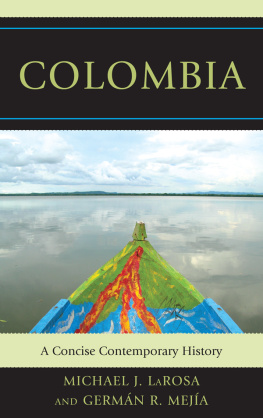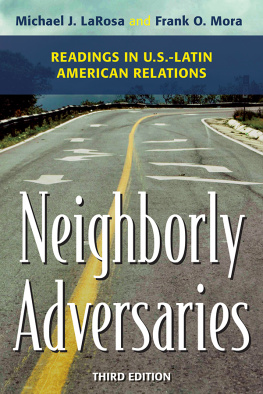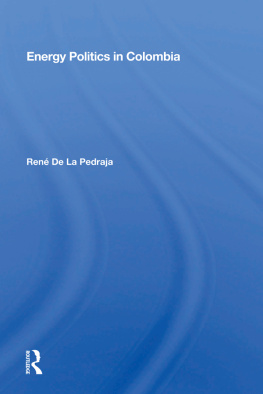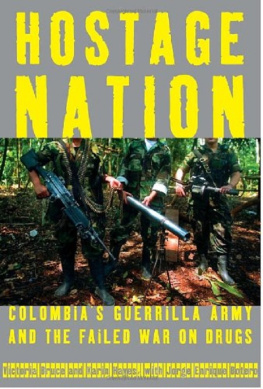Colombia
Colombia
A Concise Contemporary History
Michael J. LaRosa and Germn R. Meja
Rowman & Littlefield Publishers, Inc.
Lanham Boulder New York Toronto Plymouth, UK
Published by Rowman & Littlefield Publishers, Inc.
A wholly owned subsidiary of The Rowman & Littlefield Publishing Group, Inc.
4501 Forbes Boulevard, Suite 200, Lanham, Maryland 20706
www.rowman.com
10 Thornbury Road, Plymouth PL6 7PP, United Kingdom
Copyright 2012 by Rowman & Littlefield Publishers, Inc.
All rights reserved . No part of this book may be reproduced in any form or by any electronic or mechanical means, including information storage and retrieval systems, without written permission from the publisher, except by a reviewer who may quote passages in a review.
British Library Cataloguing in Publication Information Available
Library of Congress Cataloging-in-Publication Data
LaRosa, Michael (Michael J.)
Colombia : a concise contemporary history / Michael J. LaRosa and Germn R. Meja.
p. cm.
Includes bibliographical references and index.
ISBN 978-1-4422-0935-0 (cloth : alk. paper) ISBN 978-1-4422-0937-4 (electronic)
1. ColombiaHistory1810 2. ColombiaCivilization. I. Meja P., Germn.
II. Title.
F2273.L37 2012
986.1dc23
2011049334
 The paper used in this publication meets the minimum requirements of American National Standard for Information SciencesPermanence of Paper for Printed Library Materials, ANSI/NISO Z39.48-1992.
The paper used in this publication meets the minimum requirements of American National Standard for Information SciencesPermanence of Paper for Printed Library Materials, ANSI/NISO Z39.48-1992.
Printed in the United States of America
To our mentors and friends, Steve and Pilar Stein of Coral Gables, Florida
Acknowledgments
We would like to thank the many people who have assisted us with the research and writing of this book. First, Susan McEachern at Rowman & Littlefield has offered professional, thoughtful insight from the earliest days of this projects development, and we thank her for her unwavering support. Grace Baumgartner, at Rowman, has been a helpful editor and adviser. June Erlick at Harvard University and Lance Ingwersen, a doctoral student in history at Vanderbilt University, each reviewed early drafts of the prospectus; Mr. Ingwersen also assisted with editing chapters of the manuscript, as did journalist Casey M. Conley from Portland, Maine.
Professor Pamela Murray graciously offered to write a foreword to this work, for which we are extremely grateful. She also provided editorial advice. Lt. Paul J. Angelo carefully and patiently edited the entire manuscript.
Writer and editor Juan Pablo Lombana assisted with research, as did historian Lina Del Castillo. Ms. Del Castillo translated segments of the book from Spanish to English. Curator Marina Pacini and historian Guiomar Dueas-Vargas, in Memphis, facilitated research, as did Martha Senn from Medelln.
At Rhodes College, we benefited from the support of students Andrew Howie, who helped with fact-checking and editing, and Cameron Goodman, who provided research and editing assistance; he also helped with the selection of photographs and compiled sections of the bibliography.
Dean Michael R. Drompp provided start-up funds from Rhodes College, and Professor Ann Viano supported our project with additional research funding from the college. Nannette Gills assisted with many administrative details.
In Medelln, Luis Ospina facilitated research at the Biblioteca Pblica Piloto, and the director of that library, Gloria Ins Palomino Londoo, warmly welcomed us, as did Sergio Carvajal of the same institution.
Daniela Lpez and Rubn Carvajal, history students in Bogot, provided the copious research that went into our chronology. Pablo Silva, an architecture student at the National University in Bogot, drew our maps, based on designs developed by Germn R. Meja. In Memphis, graphic designers Lynn Conlee and Robert Shatzer edited and assisted with final design of the maps, and Joseph Morris, with little more than an iPhone 4 in hand, helped with statistical interpretation. Jeffrey A. Knowles compiled our index. Matt LaFevor helped review page proofs. Were extremely grateful for the patience, perseverance, and in many cases, warm friendship of the many people who assisted us with this project.
Foreword
Like the two authors of this book, my connection to Colombia is personal as well as professional. It started in the mid- to late-1960s with childhood visits to my mothers native Medelln. Compared with places like Buenos Aires, Rio de Janeiro, Havana, Mexico City, or even Colombias own capital of Bogot, Medelln back then was a rather obscure Latin American city. Few here in the United States had heard of it. Although humming with modern entrepreneurial energy, it still had a sedate, small-town feelnot yet that of todays hurried, more sophisticated metropolis with its sleek light rail and high-rises commanding the slopes of the Aburra Valley. It was a city of neighborhoods, churchgoing and family oriented; a place where everyone seemed to know everyone; and where guests, including the relatively rare foreigner, could expect a place of honor along with invitations to long visits (their eager-to-please hosts feeling offended if they left too soon). Children were at the center of things, the youngest and whiniest invariably spoiled and catered to. Exotic relatives such as my sisters, gringas all three, and I always found a warm reception, our broken Spanish tolerated with good humor. It was through this family that I first came to know Colombia and a people that were kindly, confident, and can-do, possessed of a certain flair. Life, while serious, was to be enjoyed, lived with zest. I became an admirer. Authors Michael LaRosa and Germn Meja no doubt would find this entirely reasonable.
Which brings me to the point of this foreword. LaRosa and Meja have performed a rare service for the broad U.S. reading public: that of offering a comprehensive, up-to-date, deeply informed, and highly readable primer on Colombiaa country that, despite its size, wealth, and geopolitical importance, remains one of the least known and most misunderstood countries in Latin America. Although both authors are professional historians, their book is no traditional academic history. It is unabashedly presentist, as historians sometimes, rather sniffily, say. Its ten chapters aim less to dissect the mysteries of the past, an exercise dear to scholars, than to explain, as concisely as possible, how Colombia became what it is today. Overall, they stress Colombias emergence as a viable, indeed successful, modern nation.
This claim may surprise some readers. Since the 1980s, most knowledgeable observers have portrayed Colombia as something of a failure or, at least, a huge disappointmenta country racked by chronic sociopolitical violence rooted in, among other things, inherited partisan hatreds; severe social inequities; a weak, corrupt state; and, not least, the influence of a vast, insidious, and illegal drug industry. The grim accounting of this violence and its diverse manifestationsfrom in-depth studies of the notorious mid-twentieth-century partisan conflictcumnational killing spree known as La Violencia through contemporary reports on the culture of youthful assassinshas dominated writing on the country here and abroad. Then there are the traditionally lurid portrayals of Colombia in the mass media. In addition to a mainstream press addicted to coverage of murder and mayhem, Miami Vice , the popular 1980s television series (recently the basis of a movie with the same name), along with Hollywood films like Blow , have ensured that, in the United States at least, the countrys image remains closely linked to drugs and violence.
LaRosa and Meja dont deny the truth that lies behind this image. They fully acknowledge the harsh realities that have been documented by scholars and researchers both in and outside the country. Yet they do ask a question seldom asked by Colombia observers. What factors have allowed Colombia, as a nation, to endure and, despite its endemic problems, to thrive? Instead of inquiring into a presumed state of illness or dysfunction, the authors inquire into the basis of relative good health: what is working, and what has worked in this bustling country of some forty-five million? Their book, thus, highlights those aspects of Colombian history and culture that have contributed most visibly to national unity as well as sustained peace and prosperity.









 The paper used in this publication meets the minimum requirements of American National Standard for Information SciencesPermanence of Paper for Printed Library Materials, ANSI/NISO Z39.48-1992.
The paper used in this publication meets the minimum requirements of American National Standard for Information SciencesPermanence of Paper for Printed Library Materials, ANSI/NISO Z39.48-1992.